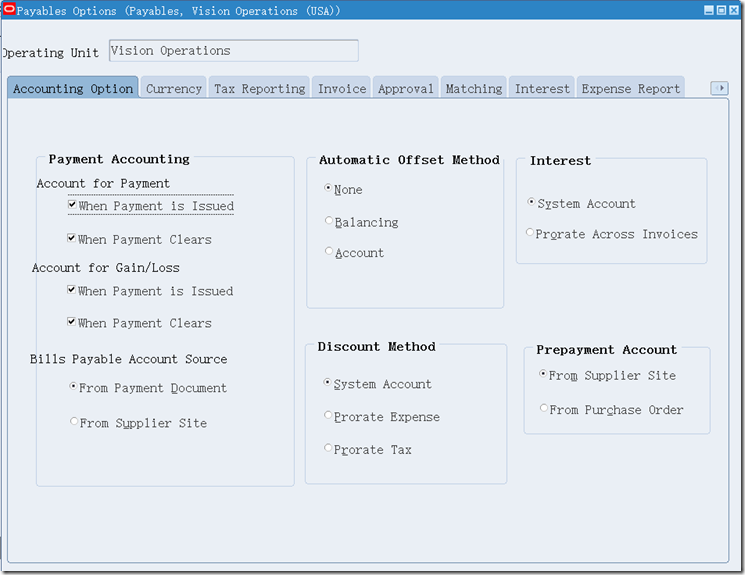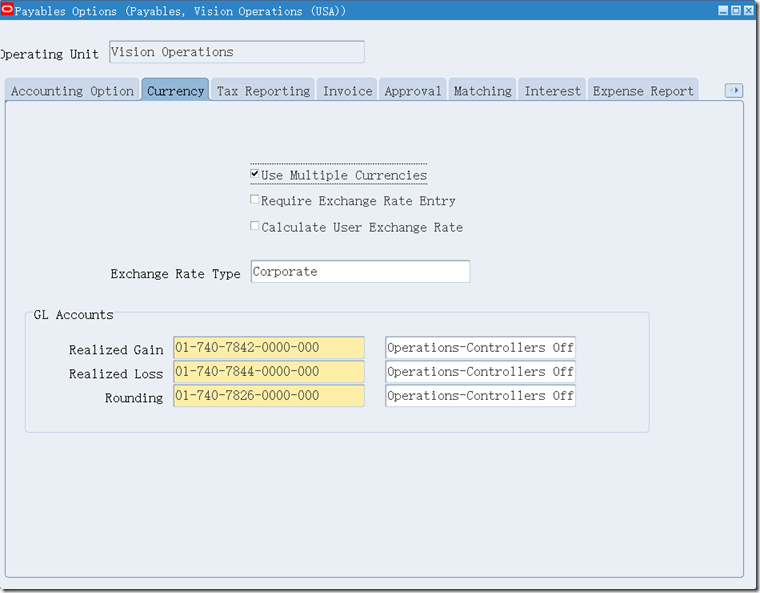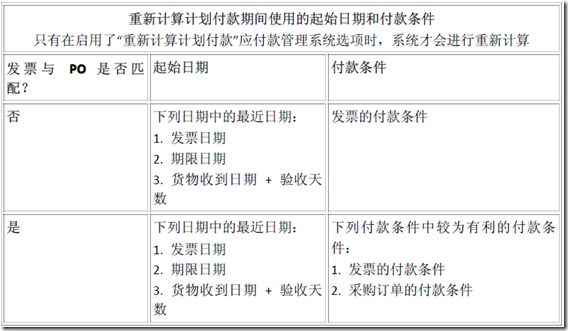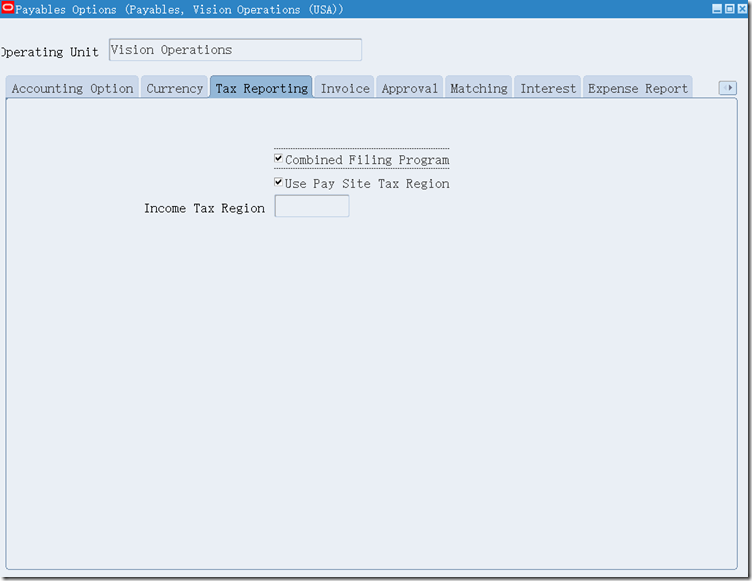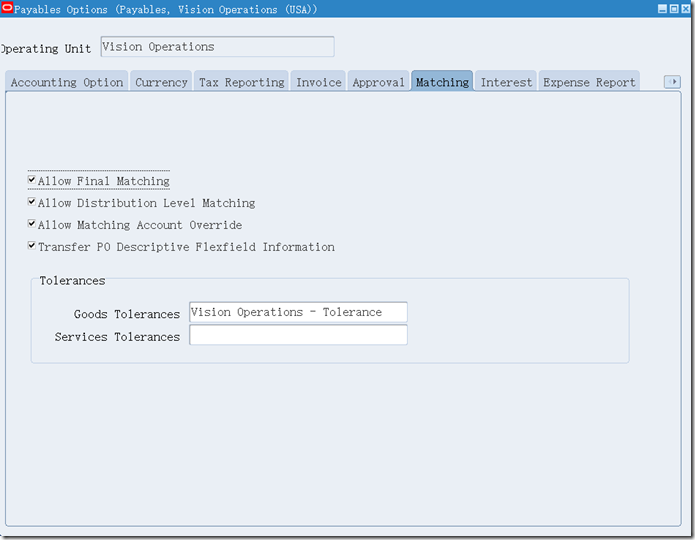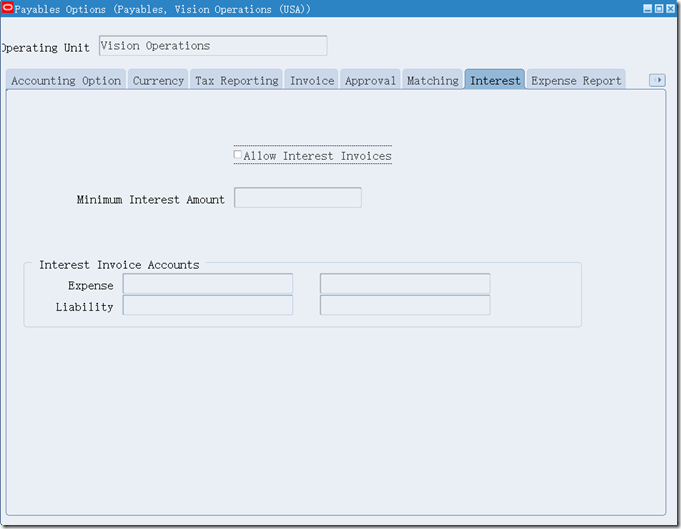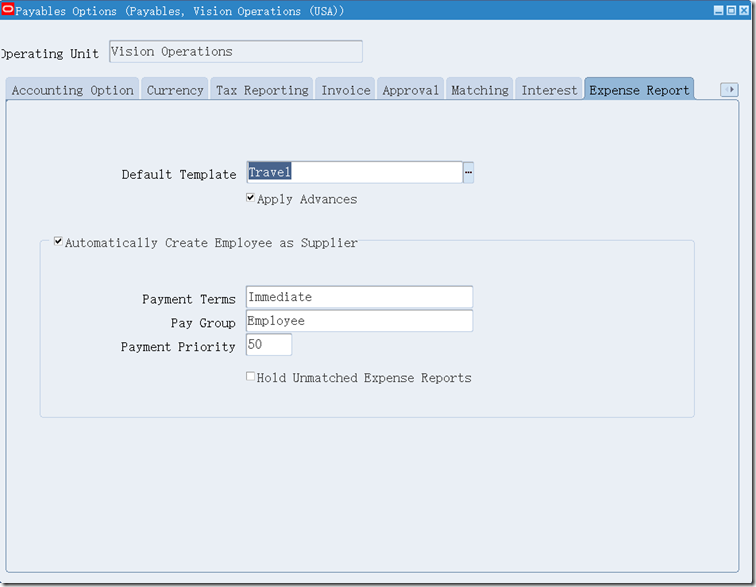(N) AP > Setup > Options > Payables Options
应付系统选项设置整个应付系统使用的控制项和默认值。我们可以在此窗口中设置默认值,从而简化供应商输入、发票输入和自动付款处理。这些选项设置好后是可以随时更改的。
会计选项(Acounting Option)
发放付款时(When Payment is issued)
在发放付款后,应付款管理系统会将每项付款记一次帐。并会生成如下会计分录:
未调节付款:
借AP 负债账户
贷现金账户
远期付款:
借AP 负债账户
贷远期负债账户
在付款到期时:
借远期负债账户
贷现金账户
(应付系统管理选项并不会再调节时创建付款调节、银行手续费、银行差错或损益的会计分录)
结清付款时 (When payment Clears)
应付系统会在结清付款后将每一项付款记账一次。
将损益记账(Account for Gain/Loss)选择记录外币付款的汇兑损益时间。
货币(Currency)
Usemultiple currencies (使用多种货币)
启用此选项后可以输入和支付不同于本位币币种的发票,并且在应付系统中还可以设置多币
种付款格式和银行账户。
禁用词选项(从启用更新到禁用)应付系统将对系统进行检查。如果在检查中发现了任何正
在使用多币种付款格式的多币种银行账户,系统会发出警告信息。注:在将此应付管理系统
选项改为禁用之前,必须停用那些使用多币种付款格式的付款单据,并将多币种银行账户中
的“多币种”字段值改为禁用。
Require Exchange Rate Entry (要求输入汇率)
要在输入的发票或付款不是本位币时要求输入汇率,需要启用此选项。如果是在“每日汇率”
窗口中维护每日汇率,应付款管理系统将根据输入的日期和汇率类型还自动默认汇率。如果
使用“用户”汇率类型。则即使未启用次选项,应付管理系统仍将始终要求输入汇率。如果
为输入汇率。则无法为外币发票创建会计分录或对其进行支付。在输入发票或是创建付款之
后,可以人工输入汇率,也可以通过使用自动汇率生成程序进行输入。
在远期付款时,无需输入到期日的汇率。但应在创建付款之后再添加到期日的汇率,否则将
无法创建与到期日关联的会计分录。
Calculate User Exchange Rate.
If you already know the ledger currency amounts of any foreign currency invoices you are
entering, then you can enable this option so Payables can calculate and enter effective invoice
exchange rates for those invoices.
This functionality applies to invoices you enter in the Invoices window and invoices you import
from the Payables Open Interface Import program. If this option is enabled, then when you enter
a foreign currency invoice, if you select the exchange rate type of User and you provide the
ledger currency amount, then Payables calculates and enters the exchange rate.
Payables allows you to enter a value for ledger currency amount in the Invoices window only if this option is enabled.
If this option is enabled then when you enter a foreign currency invoice, you still have the option
of entering a foreign currency invoice amount and exchange rate so Payables will calculate and
enter the ledger currency amount.
Exchange Rate Type (汇率类型)(应付系统默认的汇率类型)
用户:发票录入期间或付款时人工输入汇率
即期:每日汇率,应付管理系统会从“GL 每日汇率”表自动输入发票汇率。
公司:由公司来确定应用于整个组织的汇率,,应付管理系统会从“GL 每日汇率”表自动输
入发票汇率。
自定义:在“定义每日折换率类型”窗口中定义的汇率类型。你可以根据需要定义任意多个
汇率类型。如果指定“自定义”汇率类型,,应付管理系统会从“GL 每日汇率”表自动输入
发票汇率。
GL Accounts Realized Gain/Loss 已实现损益账户
应付管理系统会将这些账户作为每个银行账户中付款的默认已实现的损益账户。如果汇率在
发票录入与付款期间发生了变动。应付管理系统会自动计算已实现损益并将记录在此账户
中。只有在使用应制会计时,应付管理系统才会记录损益。“损益账户”应付款管理系统选
项可控制应付管理系统将损益入账时间。
Rounding (舍入账户)
使用的多币种和付款币种未在付款币种精度内舍入。如:某项付款应舍入为100.001GBP,
但实际却舍入为100.00GBP,系统会将.001 的舍入误差记录到此账户中。
付款的本位币金额与负债的记录金额不相等。系统会将余额记入舍入账户已完全冲减负债。
在已部分付款的发票支付最后一项付款时会发生这种情况。
已经启用自动抵消且合并了现金账户,同时出现了舍入误差。系统会将余额记入舍入账户,
已完全冲减现金结算账户,在已部分付款的发票支付最后一项付款时会发生这种情况。
发票(Invoice)
确认日期作为发票编号。(Confirmdate as Invoice Number)如果启用了此选项,则在发票录
入期间接受发票日期作为发票编号的默认值时,应付款管理系统会显示一个弹出式窗口,其
中将显示“是否将发票日期用作发票编号?”
允许联机审批。(AllowOnline Validation) 如果要允许用户在“发票”窗口和“发票批”窗口中提
交应付款管理系统审批,要启用此选项
允许改写单据类别。(AllowDocuments Category Override)如果要允许用户改写由应付款管
理系统分配给发票的默认单据类别,要启用此选项。如果“连续编号”配置文件选项为“部分
使用”或“始终使用”(主要如不修改会出现这样的提示 FRM-40200 Field is protected against
update,如果出现这个提示,先修改profile文件,然后注销当前配置AP用的用户,在登录
就可以解决了),应付款管理系统将自动为发票分配单据类别。应付款管理系统为每个发票
类型均预定义了单据类别。系统管理员可以为发票类型定义附加单据类别。
如果“连续编号”配置文件选项为“不使用”,则应付款管理系统不会为发票分配单据类别,这
样您将无法启用此选项或为发票输入单据类别。
允许对已付发票进行调整。(AllowAdjustments to Paid Invoice)如果要允许用户更新已付发
票的分配,要启用此选项。如果启用了此选项,还可以冲销与某个采购订单单据的匹配,然
后与另一个非最终匹配的采购订单单据匹配。这表示如果您在进行发票调整时不能确保分配
总额与发票额相等,则可以对已付发票创建分配差异。由于审批流程会对发票应用“分配差
异”暂挂并阻止为发票创建会计分录,因此您在提交审批时应注意是否发生了这样的错误。
重新计算计划付款。(Recalculate scheduled payment) 应付款管理系统将使用起始日期和付
款条件来计算计划付款。例如,对于某张发票,如果起始日期为01-JAN-09,付款条件为“30
天为限”,则应于30-JAN-09 全额支付该发票。在发票录入期间,应付款管理系统将使用发
票的付款条件,并将发票的期限日期用作起始日期,以此来自动计算发票的计划付款
发票期限日期其实就是发票计算到期的起始日期,通常有发票日期、系统日期,
然后基于这个起始日期加上付款计划算出发票的到期日
有的翻译为“发票到期基准”即baseline normally, GL DATE BASIS 设为SYSTEM DATE 更加合理,
以系统日期作为总帐入帐日期,要不OIE 报销以前日期的发票,费用报告审核之后无法导入
到AP, that will be a potential issue.)
如果在应付款管理系统选项中启用了“ 重新计算计划付款Recalculate scheduled
payment”,则应付款管理系统将在审批期间自动重新计算发票的计划付款。在重新计算期
间,应付款管理系统将使用最近的可用起始日期选项和最有利的可用付款条件选项,以优化
现金的流动。应付款管理系统将通过对在“付款条件”窗口中为付款条件分配的等级进行比
较,以确定较为有利的付款条件。下图显示了应付款管理系统在重新计算期间使用的选项。
发票与采购订单的匹配与否,决定了不同的可用选项。
Allow Remit-to AccountOverride. (允许修改汇款账户)
如果你希望允许用户在生成批量付款和快速付款的过程中更改默认的主供应商站点的银行
账户信息,请启用此选项。如果你启用了这个选项,你能够修改应付系统在应付窗口内的汇
款到区域内的默认信息。你能够从供应商站点启用的银行的列表中选择一个汇款账户以更改
默认的汇款账户,但是此银行主货币必须系统默认货币一致。如果你不启用此选项。你仅仅
能够从计划付款窗口修改汇款账户信息。
Check this check box if you want to allow users to change the default primary supplier site bank
account during Quick payment and payment batch creation. If you enable this option, you can
override the Payables default of the Remit-to field of the Payments window and the Modify
Payment Batch window. You can then select an alternate Remit-to account from a list of the
supplier site's active bank accounts that use the same payment currency. If you do not enable
this option, you can override the Remit-to bank account only in the Scheduled Payments window.
Allow Remit To Supplier Override. (允许修改汇入的供应商)
如果启用次选项,你能够子发票窗口修改系统默认的汇入供应商的名称和站点信息
If this option is enabled, then you can override the default Remit To Supplier Name and Site
values at the Invoice windows
Receipt Acceptance Days. (收货单接收日期)
定义你所接受的收货单的滞后或提前的时间段
Number of days you accept receipts.
运费帐户。(Freight Account)
如果启用了“自动创建运费分配”应付款管理系统选项,则您必须输入运费帐户。应付款管
理系统会将此帐户用作发票的默认运费帐户。您可以在发票录入期间改写此帐户。另请参阅:
输入发票上的运费
GL 日期基准。GL Date Basis
在发票录入期间要应付款管理系统将其用作发票的默认会计结算日期的日期。
发票日期。在发票录入期间输入的发票日期。
系统日期。应付款管理系统的当前日期;输入发票的日期。
货物收到/发票日期。在“货物收到日期”字段中输入的日期。如果未输入值,则使
用发票日期。
货物收到/系统日期。在“货物收到日期”字段中输入的日期。如果未输入值,则使
用系统日期。
预付款结算天数。(Settlement Days)
要应付款管理系统添加至系统日期以计算预付款的默认结算日期的天数。应付款管理系统将
阻止您用预付款来核销发票,直到结算日期(或结算日期之后)为止。
预付款的付款条件。(Payment Terms)
要用于所有预付款的付款条件。例如,您可能需要使即期付款条件适用于所有预付款类型的
发票。请注意,在供应商层或供应商地点层不存在此值;系统会将您在此处输入的值
默认至所有预付款发票。如果您未在此处输入值,则应付款管理系统会将发票付款条
件的供应商地点值默认值输入的预付款。
Tax %. 对于销售和用户定义的纳税类型,应付系统发票校验允许在设定的允许的误差范围内
输入。每个分配的税收金额等于的分配总金额乘以应纳税种的税率
For Sales, Offset, and user-defined tax types, Payables Invoice Validation verifies that within
the tolerance you enter here, each tax distribution amount equals the sum of the
distributions that are taxable by the tax code, multiplied by the tax rate of the tax code
Tax Amount Range.
用来定义实际发票的税额与计算税额的差异
The amount of variance you allow between the actual invoice tax amount and the
invoice calculated tax amount.
税报表(Tax Reporting)
一般默认即可,主要和系统内的1099 供应商相关主要用于美国的税务制度。
Combined Filing Program.
如果你想使用1099 的报告形式,你需要启用此选项。当你提交了1099 报告,应付系
统会会对所有的税务管辖区内的能够进行付款操作的申请联合程序生成K-records
Enable this option if you are using 1099 Combined Filing Program reporting. When you
submit the 1099 Electronic Media report, Payables will produce K-records for all tax regions
participating in the Combined Filing Program that have qualifying payments.
Note: If you use electronic filing or magnetic media to file your tax information with the Internal
Revenue Service and you are not participating in the Combined Filing Program, do not
enable this option. The Internal Revenue Service may return your 1099 magnetic tape if the
tape contains K records.(如果你使用了电子或磁介质在国税局来保存你的税务信息和
你没有使用申请联合程序。你不必启用这个选项。如果磁盘中含有K records,国税局
将发放给你一个1099 格式的磁盘。)
Use Pay Site Tax Region.
如果你希望使用1099 供应商站点的区域信息作为默认的税务区域信息,你需要启用这
个选项。在这种情况下应付系统将1099 供应商站点信息作为缺省的发票的税务管辖
区。你能够在分配发票的窗口更改发票的税务管辖区的默认信息。
You can enable this option only if you enable the Combined Filing Program Payables option.
Enable this option if you want to use a 1099 supplier's tax region as the default tax region.
If you enable this option, Payables uses the 1099 supplier site's region as the default tax
region for the invoice distributions. You can override this default region for each invoice
distribution in Distributions window.
如果你不需要使用1099 供应商站点的区域信息作为默认的税务区域信息,则不必启用
这个选项。在这种情况下你必须输入缺省的税务管辖区。你在下面的是所得税区域名
内可以对所有的发票都使用你输入的设置。
Do not enable this option if you do not want to use a supplier site's tax region as the
default tax region. You must then enter the default tax region you want to use for all
invoices in the next field, the Income Tax Region Name field.
缺省的选项是判断应付系统需在1099 电子介质中创建多少个K records。应付系统将对
每一个税务管辖区域创建一个K records。如果你有一个联合申请程序,应付系统将会
将你1099 中的应付信息转发到所有的税务管辖区域的联合申请程序中。如果你启用
了这个选项,系统将为你所有的供应商站点生成K records
The default you choose here determines how many K records Payables will produce on your
1099 Electronic Media. Payables produces one K record for each tax region. If you are
participating in the Combined Filing Program, Payables forwards your 1099 qualifying
payment information to all the tax regions that participate in the Combined Filing Program.
If you enable this option, you may have as many K records as you have different supplier tax
regions.
如果你选择了所得税管辖区域。系统只为你生成一个K record。这个K record 将作为
一个默认的税务管辖区。你可以发票分配的时候修改默认的税务管辖区。在这种情况
下,应付系统将为1099 供应商电子介质生成附加K records,每一个K record 对应一个
税务管辖区。应付系统仅仅能够为在联合申请程序和你已经输了应付分配信息的1099
供应商创建K record。你也能够选择你的1099 供应商的信息,通过在所得税区域输入
信息把你的1099 供应商信息转发到一个税务管辖区域。
If you choose a default Income Tax region in the next field, you may have only one K record.
This would be a K record for that one default tax region. Of course, you can always override
the default tax region for each invoice distribution. In this case, Payables will then produce
additional K records on your 1099 Electronic Media, one K record for each tax region.
Payables only produces K records for tax regions that participate in the Combined Filing
Program and that you have entered (either as a default or manually) on a paid distribution
for a 1099 supplier. You can also choose to have your 1099 payment information forwarded
to only one tax region regardless of which region your 1099 suppliers do business from. You
do this by entering a value in the following Income Tax Region name field.
Income Tax Region.
只有在你启用了联合申请程序和禁用了Use Pay Site Tax Region 你才能够启用这个选
项。输入你所使用的税务管辖区作为默认的1099 供应商的发票分配信息。你能够在分
配发票的时候修改这里的信息。
You can enter this field only if you enable the Combined Filing Program Payables option and
did not enable the Use Pay Site Tax Region option. Enter the tax region you wish to use as
the default for the invoice distributions of your 1099 suppliers. You can override this default
region for each invoice distribution.
审核(Approval)
Use Invoice Approval Workflow.
如果你想使用发票审批工作流特性来自动进行发票审批流程。需要启用次选项。自动审批工
作流将判断是否每一张发票都需要应付系统单独审批整张发票或是仅仅是审批发票的某一
行,自动审批流设定的审批人将决定批准还是拒绝待批的发票。当你启用了这个选项所有的
发票必须通过发票审批工作流来进行审批
Enable this option if you want to use the Invoice Approval Workflow feature to automate your
invoice approval process. The workflow determines if an invoice needs any individuals to approve
payment of the entire invoice (document) or invoice line, and if so, automatically routes the
invoice to designated approvers who then approve or reject the invoice document or line. When
you enable this option, almost all invoices must be processed by the Invoice Approval Workflow.
Note: The system automatically initiates invoice approval workflow for self service invoices that
are not matched to a purchase order and that come from iSupplier Portal or the Payables
Request responsibility.
Allow Force Approval.
如果你使用审批工作流程序并且希望应付系统账户能够修改审批工作流和手工审批发票,你
需要启用此选项。你可以在发票操作窗口进行此操作。
Enable this option if you use the Invoice Approval Workflow Program and want to allow accounts
payable processors to override the workflow and manually approve invoices or invoice lines. Use
the Invoice Actions window to manually approve the invoice document or the Force Line
Approval check box to manually approve the invoice line. For example, you might want to force
approve an invoice if the Invoice Approval Workflow does not complete for an invoice, or if you
have authority to pay an invoice without using the workflow process. See: Invoice Approval
Workflow Overview.
Approval Processing Sequence.
如果需要对系统执行的结账,审批和校验过程编号,需要启用此选项
Select the order of how the system executes the accounting, approval, and validation processes.
Note: For self-service invoices that are not matched to a purchase order and that come from
iSupplier Portal or the Payables Request responsibility, approval is always required before
validation regardless of the option selected.
Options included:
• Require Validation Before Approval.
审批之前进行校验
If you enable this option, then Invoice Approval Workflow does not select any invoice for
processing unless the invoice status is Validated. You might want to enable this option if
you need the Invoice Validation process to create tax distributions for an invoice before
approvers review it. See: Invoice Validation andInvoice Approval Workflow Overview.
You cannot enable this option unless you first enable the Use Invoice Approval Workflow
Payables option.
• Require Accounting Before Approval.
审批之前结账
If you enable this option, then Invoice Approval Workflow does not select any invoice for
processing unless the invoice status is Accounted. The validation process always runs
before the accounting process. See: Invoice Validation andInvoice Approval Workflow
Overview.
匹配(Matching)
允许最终匹配。(Allow Final Matching)
启用此选项以允许最终匹配与采购订单匹配的发票。在输入发票期间将发票与采购订单匹配
时,或在调整匹配发票分配时,您可以指明最终匹配。在将发票与接收匹配时,则不能最终
匹配。
注意:如果最终与采购订单匹配,系统会暂挂与采购订单匹配的任何后续发票,而且您不能
人工释放该暂挂。
允许分配层匹配。(AllowDistribution LevelMatching)
如果要允许与采购订单分配匹配,请启用此选项。如果您启用此选项,则可以将发票与一个
或多个采购订单分配相匹配。如果未启用此选项,应付款管理系统将只允许将发票与采购订
单发运匹配。
允许改写匹配帐户。(Allow Matching Account Override)
如果要允许改写从匹配采购订单创建的发票分配帐户,请启用此选项。您可以在发票工作台
的“分配”窗口中,或依据导入发票改写匹配发票分配的帐户。如果使用保留会计或永久接收
应计,则不能改写匹配发票分配的帐户。另外,如果采购订单与项目相关,并且采购订单分
配的物料目的地是库存,则不能改写此帐户。
传送 PO 说明性弹性域信息。(Transfer PO Descriptive Flexfield Information)
在将发票与采购订单匹配时,如果要应付款管理系统自动将说明性弹性域信息从采购订单分
配传送至发票分配,请启用此选项。如果启用了此选项,请确保采购订单分配和发票分配的
弹性域结构相同
Goods Tolerances. (货物允许的差异范围)
The tolerance template used for goods tolerances.
Services Tolerances. (服务允许的差异范围)
The tolerance template used for services tolerances.
利息(Interest)
计划允许发票计息
Allow Interest Invoices. 允许发票计息
如果你允许应付系统对供应商的过期未付款和计息发票计算利息,需要启用次选项。启用这
个选项后应付系统在付款时会在批量付款和快速付款窗口对过期未付款的发票自动生成发
票利息。如果你手动为过期未付款的发票付款时,应付系统会给你需要付息的提示,要求你
在批量付款和快速付款窗口付款。
Enable this option if you want to allow Payables to calculate interest for overdue invoices and
create interest invoices for selected suppliers. Payables automatically create interest invoices
when you pay overdue invoices in a payment batch or with a Quick payment. If you pay an
overdue invoice using a manual payment, Payables warns you that interest is due on the invoice
and you should pay the invoice in a payment batch or with a Quick payment.
如果你启用了这个选项,在会计操作管辖区内的发票交叉委派操作会指明应付系统付息的账户。
If you enable this option, the setting of the Prorate across Invoices option on the Accounting
Option region indicates how you want Payables to account for interest invoices.
启用了这个选项后,对在该地区的所有供应商窗口录入的新供应商都起作用。你可以在任何
时候对供应商修改这里的默认值。如果你没有启用这个选项,你不能够在供应商窗口启用对
发票计息。
When you enable the Allow Interest Invoices Payables option, Payables enables the Allow Interest
Invoices option in the Payment Region of the Suppliers window for all new suppliers you enter.
You can override this default value at any time. If you do not enable the Allow Interest Invoices
Payables option, you cannot enable the Allow Interest Invoices option in the Suppliers window.
MinimumInterest Amount.
如果你启用了允许发票计息,你必须在这个区域内输入一个值,这个值表示应付系统所付利
息的最小值。如果发票计息后的生成的利息值小于这个值。应付系统将不会为发票付息。
If you enable the Allow Interest Invoices option, you must enter a value in this field that
represents the minimum interest amount Payables will pay. If the calculated interest amount is
less than this amount, Payables does not create an interest invoice.
Note: Because interest payments compound every thirty days, we suggest you pay interest when
it is due, rather than allowing it to compound. Set the minimum interest amount low enough so
that your interest does not compound, but not so low that you pay very exceedingly small
amounts of interest on past due invoices.
Expense Interest Invoice Account. 发票利息费用账户
如果Prorate Across Invoices option 在账户操作区域被禁用,应付系统会生成一个单独的发票
利息账户。
If the Prorate Across Invoices option on the Accounting Option region is disabled then when
Payables creates an interest invoice it creates a single distribution with this account.
如果Prorate Across Invoices option 在账户操作区域被启用,应付系统会使用你在建立费用发
票费用利息账户是创建的natural (charge) account。
If the Prorate Across Invoices option is enabled then Payables uses the natural (charge) account
from the account you enter here when it builds expense accounts for an interest invoice.
Liability Interest Invoice Account. 发票利息负债账户
如果你启用了允许发票计息,你必须在这个区域内输入一个负债账户。应付系统将使用这个
账户作为创建发票利息的负责账户。这个账户将在付款过程中始终被利息自动生成系统所使
用。如果你启用了动态抵消账户,你将不能修改此账户。
If you enable the Allow Interest Invoices option, you must enter a liability account. Payables uses
this account as the liability account when it creates accounting entries for interest invoices. This
liability account is always used when interest invoices are automatically created during the
payment process. Payables does not overwrite the liability account if you use Automatic Offsets.
费用报表(Expense Report)
默认模板。Default Template
要在应付款管理系统“费用报表”窗口中使用的默认费用报表模板。您可以在“费用报表”窗口
中改写此值。只有在费用报表模板有效时,默认费用报表模板才会显示在“费用报表”窗口中。
付款条件。Payment Terms
要分配给任何供应商(在发票导入期间根据员工所创建)的付款条件。
建议:为员工供应商定义并分配即期付款条件。
支付组。Pay Group
要分配给任何供应商(在发票导入期间根据员工所创建)的支付组。您可以在采购管理系统
的“查找”窗口中为支付组定义附加值。
付款优先级。Payment Priority
要分配给任何供应商(在发票导入期间根据员工所创建)的付款优先级。它是一个介于1
(上限)和99(下限)之间的数字,表示供应商的付款优先级。
核销预付款。Hold Unmatched Expense Reports.
是指应付款管理系统的“费用报表”窗口中“核销预付款”选项的默认值。如果启用了此选项,
则如果员工具有任何未付的可用预付款,应付款管理系统将用该预付款来核销员工费用报
表。您可以在费用报表录入期间改写此默认值。
自动将员工创建为供应商。Automatically Create Employee as Supplier
如果启用了此选项,则在导入应付款管理系统费用报表时,应付款管理系统将自动为任何费
用报表(其中员工尚未作为供应商而存在)创建供应商。如果要支付的某个供应商地点(“住
宅”或“办公室”)尚不存在,则应付款管理系统会将该供应商地点添加至现有供应商。根据
您要支付的费用报表地点的不同,系统会使用相应的地址来创建“住宅”或“办公室”供应商地
点。“住宅”地址包含在PER_ADDRESSES 表中,而“办公室”地址包含在HR_LOCATIONS 表中。
应付款管理系统将根据您在此区域中选择的默认值以及“输入人员”窗口中的员工信息来创
建供应商。您可以在“供应商”窗口中复查供应商并调整任何默认值。
如果您未启用此选项,请在“供应商”窗口中将员工输入为供应商,并在使用应付款管理系统
的发票导入流程之前将“员工姓名/编号”链接至此供应商。如果某个费用报表没有对应的供
应商,应付款管理系统将无法导入该费用报表,但会将其列入“发票导入例外”报表,并对其
应用“无供应商”暂挂。
Apply Advances. (借款申请)
此选项的默认值在应付的费用报告页签设定。如果你启用了这个选项,如果雇员有任何外部
的借款行为,应付系统将会将雇员的借款信息添加进雇员费用报告。你能够在费用报告生成
期间的任何时期修改此项的默认值。
如果你使用了internet 费用并且你启用了此项,费用报告将添加所有的外部借款信息。这些
信息的范围是从最早的信息到Internet 费用报告。
Default value for the Apply Advances option in the Expense Reports window in Payables. If you
enable this option, Payables applies advances to employee expense reports if the employee has
any outstanding, available advances. You can override this default during expense report entry.
If you use Internet Expenses and you enable this option, then Expense Report Export applies all
outstanding, available advances, starting with the oldest, up to the amount of the Internet
expense report.
付款(Payment Payables)
计算折扣时扣除税。Exclude Tax From Discount Calculation
如果启用此选项,则您可以输入发票;如果您使用题头层计税,则应付款管理系统会在“发
票”窗口中输入可折扣的发票额时,从发票额中减去税额。如果启用此选项,则不能为“折扣
分配方法”应付款管理系统选项选择“按比例分摊税”。请注意,即使启用了此选项,折扣计
算也不会扣除具有相应抵销税的税(如增值税)。
如果未启用此选项,应付款管理系统会使用发票总额(包括税额)作为可用于折扣的发票额。
在输入发票时,您始终可以改写可用于折扣的默认发票额
允许提前。Allow Pre-Date.
如果启用此选项,应付款管理系统允许您创建付款日期早于系统日期的付款(除人工付款
外)。
允许撤消及补发。Allow Void and Reissue
如果启用此选项,您可以补发快速付款。如果支票在打印期间被损坏,则需要补发支票。在
补发支票时,应付款管理系统会撤消旧支票并创建替换支票。如果使用多币种,则新旧支票
相同,只是新支票具有新支票编号、付款日期和付款汇率。
您不能为远期付款选择“撤消及补发”选项。
允许地址变动。Allow Address Change
如果要允许用户将付款发送至发票供应商地点地址以外的其它地址,请启用此选项。
允许改写汇入帐户。Allow Remit To Supplier Override
如果要允许用户在创建快速付款和付款批过程中更改默认的主要供应商地点的银行帐户,请
选定此复选框。如果启用此选项,您可以改写“付款”和“修改付款批”窗口中“汇入”字段的系
统默认值。然后,您可以从使用相同付款币种的供应商地点有效银行帐户列表中选择一个备
选汇入帐户。如果未启用此选项,您仅可以在“计划付款”窗口中改写汇入银行帐户。
Enable Bank Charge Deduction fromPayment.
Enable this option if you want to allow users to deduct bank charges (扣除银行费用)from
payment.
Deduct Bank Charge fromPayment.
If the Enable Bank Charge Deduction from Payment check box is enabled, you can set the
deduction to one of the following options: No; Supplier/Negotiated; or Supplier/Standard.
(供应商、协商或是供应商、标准)
代扣税(Withholding Tax)
UseWithholding Tax.
如果你启用了自动代扣所得税,你需要允许你的供应商接受应扣所得税额。
Select this option to enable Automatic Withholding Tax. If you enable this option, you have the
option to allow your suppliers and supplier sites to be subject to withholding tax.
Allow Manual Withholding.
手动调整代扣所得税,启用次选项后,你可以对发票手动调整代扣所得税的分配
Enable this option to allow manual creation and adjustments of Withholding Tax type
distributions for your invoices.
Tax Group.
新建供应商时输入的默认代扣所得税税务组
The name of the withholding tax group that you would like to use as the default withholding tax
group for the new suppliers you enter.
Apply Withholding Tax.
选择此项你将使你的应付系统对你的供应商发票何时申请代扣所得税
Select the time at which you would like Payables to apply withholding taxes to your supplier's
invoices:
• Never. (从不)
• At Invoice Validation Time. (在发票校验时)
Note: If Payables withholds tax at Invoice Validation, it calculates withholding only once. If you
adjust an invoice after you submit Invoice Validation, then you need to manually adjust the
withholding tax. (如果你在提交发票后又修改了发票,你必须手动调整代扣所得税金额)
• At Payment Time. When you create payments in a payment batch or with a Quick payment.
• At Invoice Validation and At Payment Time. Indicates when the Withholding Tax is
applied, that is at the time of both Invoice Validation and at the Payment.
Withholding Amount Basis.
• Include Discount Amount. Payables includes the invoice discount amount when it
calculates withholding tax amounts for the invoice.
• Include Tax Amount. Payables includes the invoice tax amount when it calculates
withholding tax amounts for the invoice.
CreateWithholding Invoice.
Select the time at which you would like Payables to automatically create withholding tax invoices
to remit withheld taxes to tax authorities:
• Never. You can create a withholding type tax code without entering a tax authority.
However, if you change to an option other than Never, you will need to manually ensure
that each withholding type tax code has an associated tax authority. (如果你想要把此
项改为从不,你需要手动确认每一个代扣所得税税码已经关联的相关的税务机关)
• At Invoice Validation Time.
• At Payment Time.
Include Income Tax Type onWithholding Distributions. (这一项在中国很少用到,就不做翻
译了)
If you enable this option then you can report on federal income tax withheld (MISC4) for 1099
suppliers.
When this option is enabled, then when Payables automatically creates distributions of type
Withholding Tax for 1099 reportable suppliers, Payables automatically provides the following
values:
• Income Tax Type value of MISC4.
• Income Tax Region value, if the Combined Filing Payables option is enabled.
Note: Payables provides these values only for distributions it creates automatically. If you create a
Withholding Tax distribution manually, then you need to enter these values manually.
When you enable this option, Payables initiates the Update 1099 Withholding Tax Distributions
program, which updates these values on existing Withholding Tax distributions. The program
selects distributions to update as follows:
• If the current date is before March 1 of the current calendar year then the program
updates distributions with a payment date of January 1 of the previous calendar year or
later.(一月一号之前的一个年度或是只有之后的一个年度)
• If the current date is March 1 of the current calendar year or later, then the program
updates distributions that have a payment date of January 1 of the current year or later.
(一月一号所在的当前年度或是以后的年度)
报告(Report)
Sort by Alternate Fields.
你能够对供应商,供应商站点和银行账户启用别名。
如果你有针对日本的业务你可以输入汉字和假名值
You can enter alternate names for suppliers, supplier sites, and bank accounts. Use this feature if
you do business in Japan so you can enter both Kanji and Kana values.
如果你启用了此选项,应付系统可以通过别名来进行排序分类(这些分类可以根据供应商,
供应商站点和银行账户信息来进行,但是打印时,在报告上仍然是标准的供应商,供应商站
点和银行账户信息)
If you enable this option then Payables sorts by values in the alternate fields whenever it sorts
reports by supplier name, supplier site name, and bank account name. Although Payables sorts
by the alternate name, it prints the standard name on the report.
The following table lists the reports affected by this option. If a report sorts by an alternate field
value, the table indicates this with a Yes.
| Report Name | Sorted by Supplier Name | Sorted by Supplier Site Name | Sorted by Bank Account Name |
| Accounting Entries Audit Report | Yes | ||
| Cash Requirement Report | Yes | ||
| Invoice Aging Report | Yes | Yes | |
| Invoice on Hold Report | Yes | ||
| Invoice Register | Yes | ||
| Preliminary/Final/Rejected Purged Listings | Yes | Yes | |
| Supplier Mailing Labels | Yes | Yes | |
| Suppliers Paid Invoice History | Yes | Yes | |
| Suppliers Report | Yes | Yes | |
| Unaccounted Transactions Report | Yes |
供应商(Supplier)
• Invoice Currency. 发票币别
• Pay Group. 付款组
• Terms Date Basis. 付款方式基准日期
- System
- Goods Received
- Invoice Received
• Pay Date Basis. 付款基准日期
- Discount- Due
• Payment Terms. 付款方式
